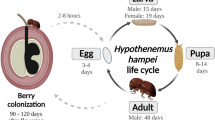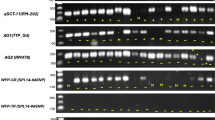Abstract
Root-knot nematodes (Meloidogyne spp.) threaten the livelihood of millions of farmers producing coffee worldwide. The use of resistant plants either as cultivars or rootstocks appears to be the single most effective method of control. A screening method was developed to evaluate large populations of plants for resistance to root-knot nematodes. Two coffee cultivars, one susceptible and the other resistant to Meloidogyne paranaensis, were grown under controlled conditions in two substrates: a commercial sieved potting compost and an inert substrate containing sand with a water-absorbent synthetic polymer. Plant growth and development and nematode multiplication were compared for two inoculation dates (2 and 8 weeks after planting) and two evaluation dates (eight and 13 weeks after inoculation). Root growth, but not nematode multiplication, was influenced by the choice of substrate. Evaluation of the differences in root weight and nematode numbers between the different cultivars, substrates and dates of inoculation suggested that an optimal condition could be defined. The best discrimination between susceptible and resistant plants was found in the experiment where inoculation occurred at 2 weeks after planting and evaluation occurred at 8 weeks after inoculation. Because the total duration of this experiment was only 3 months, high-throughput evaluation was possible, opening up new possibilities for screening large germplasm collections and studying the genetic control of root-knot nematode resistance in coffee.



Similar content being viewed by others
References
Albuquerque, E. V. S., Carneiro, R., Costa, P., Gomes, A., Santos, M., Pereira, A., et al. (2010). Resistance to Meloidogyne incognita is expressed by a hypersensitive-like response in Coffea arabica. European Journal of Plant Pathology. doi:10.1007/s10658-010-9603-3.
Alpizar, E., Etienne, H., & Bertrand, B. (2007). Intermediate resistance to the Meloidogyne exigua root-knot nematode in Coffea arabica. Crop Protection, 26, 903–910.
Anthony, F., Topart, P., Martinez, A., Silva, M., & Nicole, M. (2005). Hypersensitive-like reactions conferred by the Mex-1 resistance gene against Meloidogyne exigua in coffee. Plant Pathology, 54, 476–482.
Anthony, F., Dussert, S., & Dulloo, E. (2007). The coffee genetic resources. In F. Engelmann, E. Dulloo, C. Astorga, S. Dussert, & F. Anthony (Eds.), Complementary strategies for ex situ conservation of coffee (Coffea arabica L.) genetic resources. A case study in CATIE, Costa Rica (pp. 12–22). Rome: Bioversity International. Topical reviews in agricultural biodiversity.
Anzueto, F., Bertrand, B., Sarah, J.-L., Eskes, A. B., & Decazy, B. (2001). Resistance to Meloidogyne incognita in Ethiopian Coffea arabica accessions. Euphytica, 118, 1–8.
Barbosa, D. H. S. G., Vieira, H. D., Souza, R. M., Dias, P. P., & Viana, A. P. (2007). Desenvolvimento vegetativo e reação de genótipos de Coffea spp. A uma população de Meloidogyne exigua virulenta a cultivares resistentes. Nematologia Brasileira, 31, 1–6.
Barker, K. R. (1985). Nematode extraction and bioassays. In K. R. Barker, C. C. Carter, & J. N. Sasser (Eds.), An advanced treatise on Meloidogyne, vol. 2 Methodology (pp. 19–35). Raleigh: University Graphics.
Bertrand, B., & Anthony, F. (2008). Genetics of resistance to root-knot nematodes (Meloidogyne spp.) and breeding. In R. M. Souza (Ed.), Plant-parisitic nematodes of coffee (pp. 165–190). Springer.
Bertrand, B., Aguilar, G., Bompard, E., Rafinon, A., & Anthony, F. (1997). Comportement agronomique et résistance aux principaux déprédateurs des lignées de Sarchimor et Catimor au Costa Rica. Plantations, Recherche, Développement, 4, 312–321.
Bertrand, B., Nuñez, C., & Sarah, J.-L. (2000a). Disease complex in coffee involving Meloidogyne arabicida and Fusarium oxysporum. Plant Pathology, 49, 383–388.
Bertrand, B., Peña Durán, M. X., Anzueto, F., Cilas, C., Etienne, H., Anthony, F., et al. (2000b). Genetic study of Coffea canephora coffee tree resistance to Meloidogyne incognita nematodes in Guatemala and Meloidogyne sp. nematodes in El Salvador for selection of rootstock varieties in Central America. Euphytica, 113, 79–86.
Bertrand, B., Anthony, F., & Lashermes, P. (2001). Breeding for resistance to Meloidogyne exigua of Coffea arabica by introgression of resistance genes of C. canephora. Plant Pathology, 50, 637–643.
Bertrand, B., Ramirez, G., Topart, P., & Anthony, F. (2002). Resistance of cultivated coffee (Coffea arabica and C. canephora) to corky-root caused by Meloidogyne arabicida and Fusarium oxysporum, under controlled and field conditions. Crop Protection, 21, 713–719.
Bertrand, B., Guyot, B., Anthony, F., & Lashermes, P. (2003). Impact of Coffea canephora gene introgression on beverage quality of C. arabica. Theoretical and Applied Genetics, 107, 387–394.
Boisseau, M., Aribi, J., de Sousa, F. R., Carneiro, R. M. D. G., & Anthony, F. (2009). Resistance to Meloidogyne paranaensis in wild Coffea arabica L. Tropical Plant Pathology, 34, 53–56.
Campos, V. P., & Villain, L. (2005). Nematode parasites of coffee and cocoa. In M. Luc, R. P. Sikora, & J. Bridge (Eds.), Plant parasitic nematodes in subtropical and tropical agriculture (pp. 529–579). London: Cabi.
Carneiro, R. G. (1995). Reação de progenies de café ‘Icatu’ a Meloidogyne incognita raça 2 em condição de campo. Nematologia Brasileira, 19, 53–59.
Carneiro, R. M. D. G., & Cofcewicz, E. T. (2008).Taxonomy of coffee-parasitic root-knot nematodes, Meloidogyne spp. In R. M. Souza (Ed.), Plant-parasitic nematodes of coffee (pp. 165–190). Springer.
Carvalho, A., Medina Filho, H. P., Fazuoli, L. C., Guerreiro Filho, O., & Lima, M. M. A. (1991). Aspectos genéticos do cafeeiro. Revista Brasileira de Genetica, 14, 135–183.
Coolen, W. A., & D’Herde, C. J. (1972). A method for the quantitative extraction of nematodes from plant tissue. Ghent: State Agric. Res. Centre.
Curi, S. M., Carvalho, A., Moraes, F. P., Monaco, L. C., & Arruda, H. V. (1970). Novas fontes de resistencia genética de Coffea no controle de nematóide do cafeeiro, Meloidogyne exigua. Biológico, 36, 293–295.
Dulloo, M. E., Ebert, A. W., Dussert, S., Gotor, C., Astorga, C., Vasquez, N., et al. (2009). Cost efficiency of cryopreservation as a long-term conservation method for coffee genetic resources. Crop Science, 49, 2123–2138.
Dussert, S., Chabrillange, N., Montillet, J.-L., Agnel, J.-P., Engelmann, F., & Noirot, M. (2003). Basis of coffee seed sensitivity to liquid nitrogen exposure: oxidative stress or imbibitional damage? Physiologia Plantarum, 119, 534–543.
Gonçalves, W., & Ferraz, L. C. C. B. (1987). Resistência do cafeeiro a nematóides. II—Testes de progênies e híbridos para Meloidogyne incognita raça 3. Nematologia Brasileira, 11, 125–142.
Gonçalves, W., & Pereira, A. (1998). Resistência do cafeeiro a nematóides. IV Reação de cafeeiros derivados do Híbrido de Timor a Meloidogyne exigua. Nematologia Brasileira, 22, 39–50.
Hernández, A., Fargette, M., & Sarah, J.-L. (2004). Pathogenicity of Meloidogyne spp. (Tylenchida: Meloidogynidae) isolates from Central America and Brazil on four genotypes of Coffea arabica. Nematology, 6, 205–213.
Hussey, R. S., & Barker, K. R. (1973). A comparison of methods of collecting inocula for Meloidogyne spp., including a new technique. Plant Disease Reporter, 57, 1025–1028.
Lashermes, P., Andrzejewski, S., Bertrand, B., Combes, M.-C., Dussert, S., Graziosi, G., et al. (2000). Molecular analysis of introgressive breeding in coffee (Coffea arabica L.). Theoretical and Applied Genetics, 100, 139–146.
Morera, N., & López, R. (1988). Desarrollo y reproducción de tres poblaciones de Meloidogyne exigua Goeldi, 19887, en cafeto, cv. Catuai. Turrialba, 38, 1–5.
Negrón, J. A., & Acosta, N. (1989). The Fusarium oxysporum f.sp. Coffeae-Meloidogyne incognita complex in ‘Bourbon’ coffee. Nematropica, 19, 161–168.
Noir, S., Anthony, F., Bertrand, B., Combes, M.-C., & Lashermes, P. (2003). Identification of a major gene (Mex-1) from Coffea canephora conferring resistance to Meloidogyne exigua in Coffea arabica. Plant Pathology, 52, 97–103.
Réversat, G., & Destombes, D. (1998). Screening for resistance to Heterodera sacchari in the two cultuivated rice species, Oryza sativa and O. glaberrima. Fundamental and applied Nematology, 21, 307–317.
Réversat, G., Boyer, J., Sannier, C., & Pando-Bahuon, A. (1999). Use of a mixtures of sand and water-absorbent synthetic polymer as substrate for the xenic culturing of plant-parisitic nematodes in the laboratory. Nematology, 1, 209–212.
Seinhorst, J. W. (1950). De betekenis van de toestand van de grond voor het optreden van aantasting door het stengelaaltje (Ditylenchus dipsaci (Kuhn) Filipjev). Tijdschrift over Plantenziekten, 56, 289–348.
Silvarolla, M. B., Gonçalves, W., & Lima, M. M. A. (1998). Resistência do cafeeiro a nematóides. V. Reprodução de Meloidogyne exigua em cafeeiros derivados da hibridação de Coffea arabica com C. canephora. Nematologia Brasileira, 22, 51–59.
Taylor, A. L., & Sasser, J. N. (1978). Biology, identification and control of root-knot nematodes (Meloidogyne sp.). Raleigh: North Carolina State University Graphics.
Van der Vossen, H. A. M. (2001, May). Coffee breeding and selection: review of achievements and challenges. Paper presented at the 19th International Scientific Colloquium on Coffee of the Association for Science and Information on Coffee, Lausanne.
Acknowledgements
This research was funded by IRD (Institut de recherche pour le développement, ex ORSTOM, Marseille, France) and CIRAD (Centre de coopération internationale en recherche agronomique pour le développement, Montpellier, France). Special thanks to Edgardo Alpizar and Francisco Anzueto for providing coffee seeds. Two anonymous reviewers are also thanked for constructive critics.
Author information
Authors and Affiliations
Corresponding author
Rights and permissions
About this article
Cite this article
Villain, L., Aribi, J., Réversat, G. et al. A high-throughput method for early screening of coffee (Coffea spp.) genotypes for resistance to root-knot nematodes (Meloidogyne spp.). Eur J Plant Pathol 128, 451–458 (2010). https://doi.org/10.1007/s10658-010-9671-4
Accepted:
Published:
Issue Date:
DOI: https://doi.org/10.1007/s10658-010-9671-4




